GMS Economic Corridors
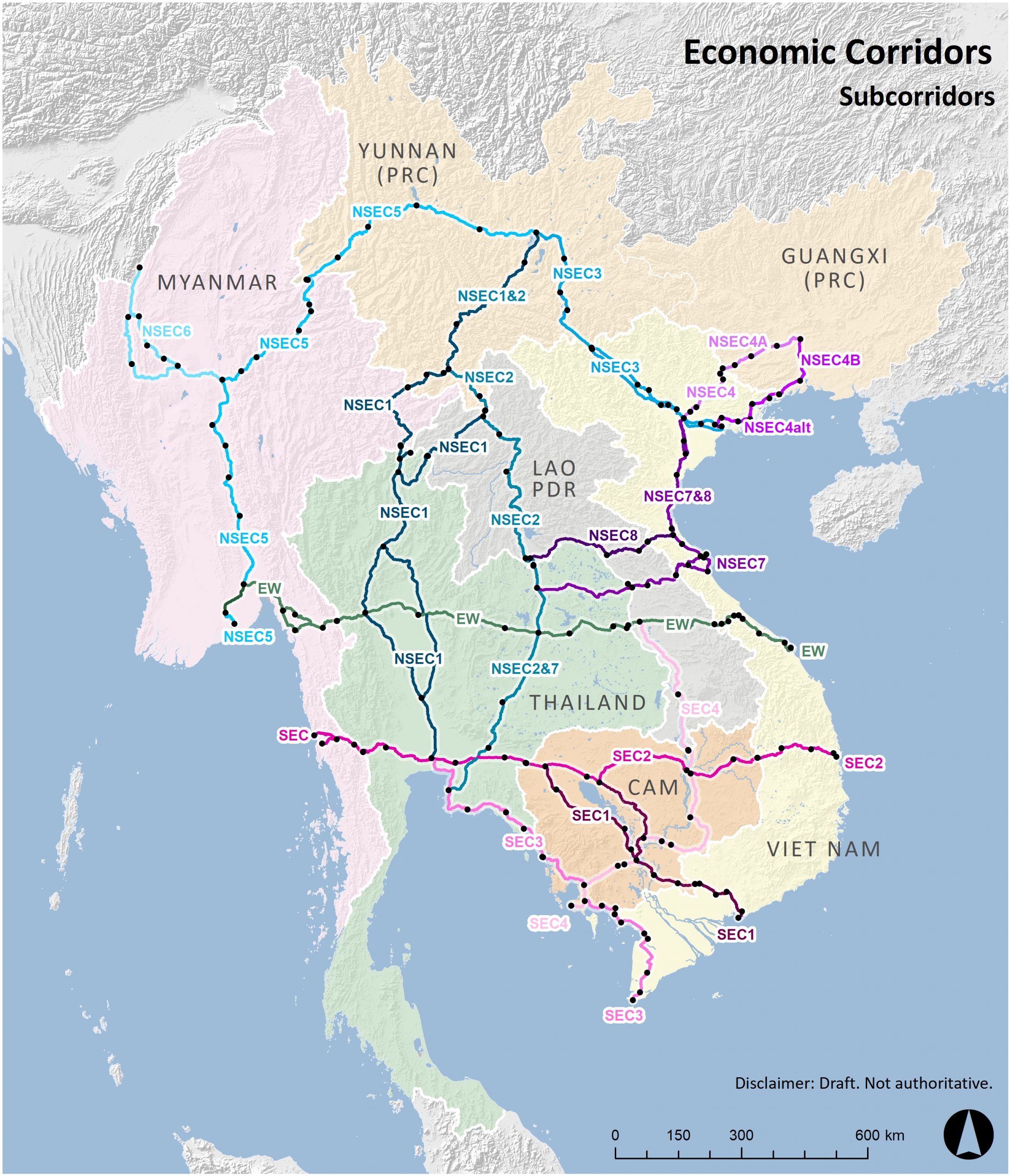
Credit: https://greatermekong.org/
The ASEAN Economic Corridor or Great Mekong Subregion Economic Corridor (GMS Economic Corridor) is an economic cooperation in the Greater Mekong Subregion (GMS) where economic cooperation among countries in natural economic zones that the Mekong River flows through 6 countries. They are Cambodia. People’s Republic of China (especially Yunnan and Guangxi Zhuang Autonomous Region), Laos, Myanmar, Vietnam and Thailand. There are approximately 2.6 million square kilometers with 326 million of population.
GMS Economic Corridors focus on development of many areas of infrastructure, especially transportation, electrical system, telecommunication, environment, and law. GMS Economic Corridors aim to distribution and logistics of products and raw material, including boosting tourism market. The ultimate goals are to promote expansion of industry in agriculture, trade, investment and services. They help driving employment, creating opportunities and improving people’s quality of life equally.
The Asian Development Bank (ADB) are the main financial supporter of GMS Economic Corridors, began in 1992 at the Mekong Ministers’ Meeting in Manila Philippines
1. North-South Economic Corridor: NSEC

1. North-South Economic Corridor: NSEC Connecting Thailand, Myanmar, Laos, and China. It consists of 3 sub-routes;
1.1 R3A Routes Connecting of South region of China, Laos, and Thailand. Starting at Kunming, China, then enter Laos at Mohan – Boten – Houayxay (Huay Xai, Bokeo province), then enter Thailand at Chiang Kong district, ending at Bangkok.
Currently, R3A Route is one of the most congested routes, after the 4th Thai-Lao Friendship Bridge (Chiang Khong-Huay Sai) was completed and officially opened on December 11, 2013.
1.2 R3B Route Starting at Kunming same as R3A Route but entering Myanmar at Tachileik, enter Thailand at Mae sai District, Chiangrai and ending at Bangkok.
1.3 R5 Routes Starting at Nan Ning in Guangxi, China to Hanoi and Hai Phong Port, Vietam. In Thailand, there are 13 provinces along NEC; Chiangrai, Payoa, Chiangmai, Lamphun, Lampang, Phrae, Tak, Kamphangphet, Uttaradit, Phitsanulok, Nakornsawan, Ayutthaya, and Bangkok.
2. East-West Economic Corridor: EWEC
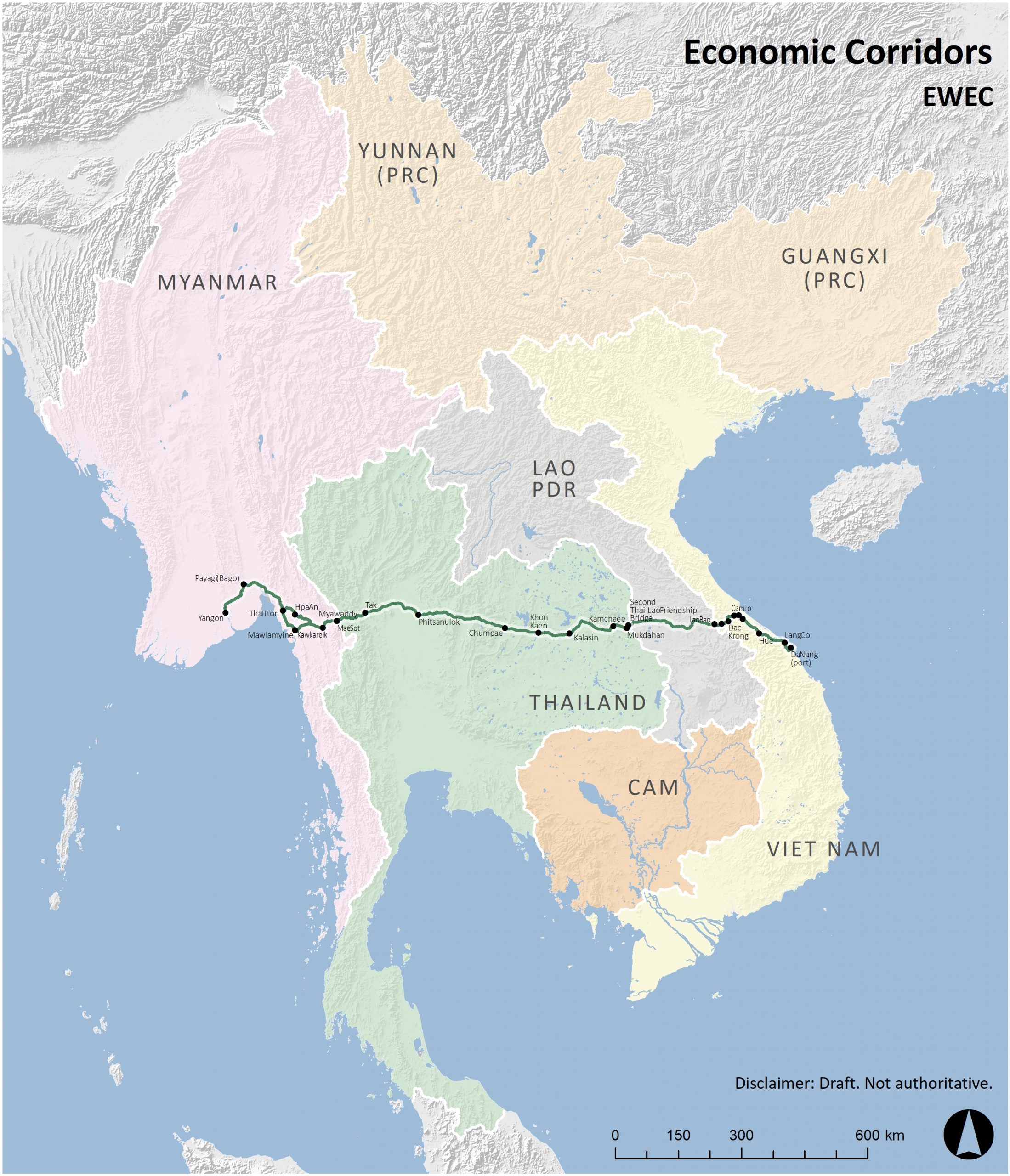
2. East-West Economic Corridor: EWEC Connecting Vietnam, Laos, Thailand, Myanmar. It is linkage between South China Sea and Andaman Sea, consists of 3 sub-routes;
2.1 R9 Route Starting Mawlamyine to Myawaddy, Myanmar, enter Thailand at Mae Sot District, Tak Province connecting to Phitsanulok, Khon Kean, Mukdahan, entering Sawannakhet, Laos, to Vietnam at Hue ending at Danung.
2.2 R12 Route Connecting Northeastern region of Thailand and Guangxi Zhuang autonomous region, China. It starts at Nakhon Phanom Province, Thailand, then enter Laos at Khammouan, enter Vietnam at Hà Tĩnh, Vihn and Hanoi, ending at Guangxi after opened the 3rd Thai-Laos Friendship Bridge (Nakhon Phanom -Khammouan) in November 1991. Currently, R12 Route is the shortest transportation from Thailand to Guangxi Zhuang autonomous region.
2.3 R8 Route Starting at Bueng Kan Province, Thailand, enter Laos at Paksan, to Vietnam at Vihn and Hanoi, ending at Guangxi, China. Thailand, there are 7 provinces along EWEC; Tak, Sukhothai, Phitsanulok, Petchabun, Khon Kaen, Kalasin, Mukdahan.
3. Southern Economic Corridor: SEC
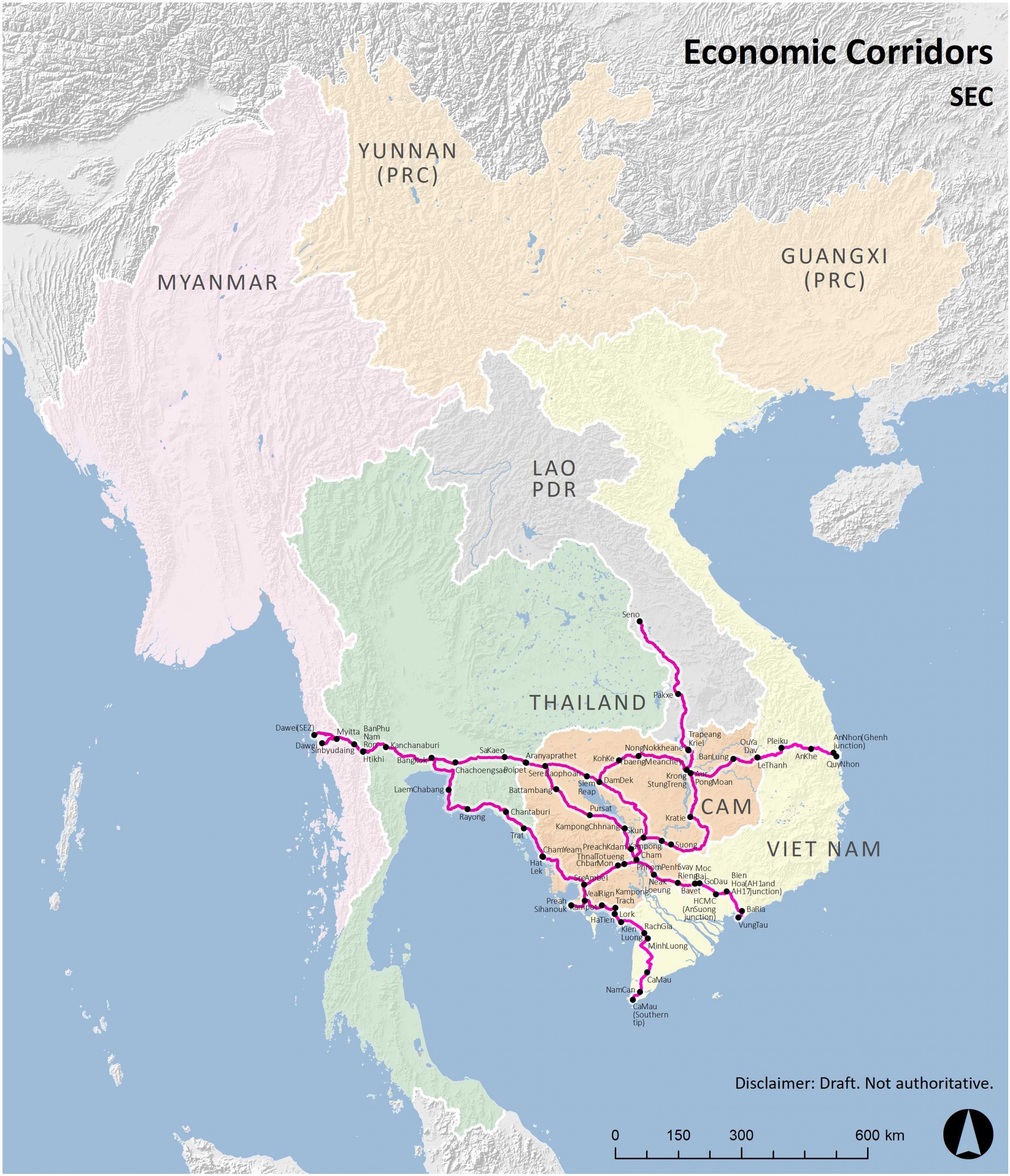
3. Southern Economic Corridor: SEC Connetng Myanmar – Thailand – Cambodia – Vietnam, consists of 2 sub-routes;
3.1 Route of Dawei – Tiki – Bangkok – Aranya Prathet – Poipet – Phnom Penh – Ho Chi Minh – Wang Tao It is the high potential route of business. It go through several important cities and high traffic cross-border Logistic along border. It includes both Aranya Prathet – Poipet Border Crossing Point between Thailand – Cambodia and Bavet international border checkpoint (Cambodian side) and Mok Bai between Cambodia – Vietnam
3.2 Route of Dawei – Tiki– Baan Nampu Ron – Bangkok – Seamreap – Stung Treng – Kwiyeon It is an important economic and tourism route between Thailand – Cambodia and connecting Thailand and Central of Vietnam by passing Cambodia and 8 provinces of Thailand; Chachoengsao, Prachinburi, Sakaew, Cholburi, Rayong, Chanthaburi, Trad and Kanchanaburi
*Stung Treng Cambodia Lao Border
How efficiency of EWEC and NEC
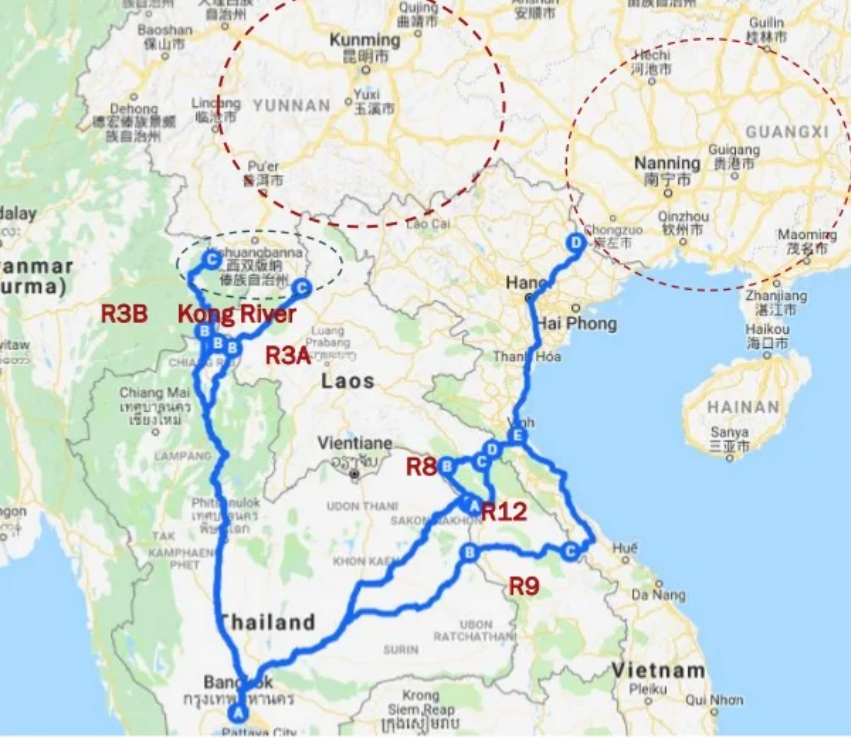
Road and Water Transportation
Road transportation consists of 4 routes for Cross-Border Trade; R9, R12, R3A, R3B. Water transportation along Mekong River to 4 ports; Jihong Port, Dongguan Port, Kuan Lam Pa Port, Se-mao Port.
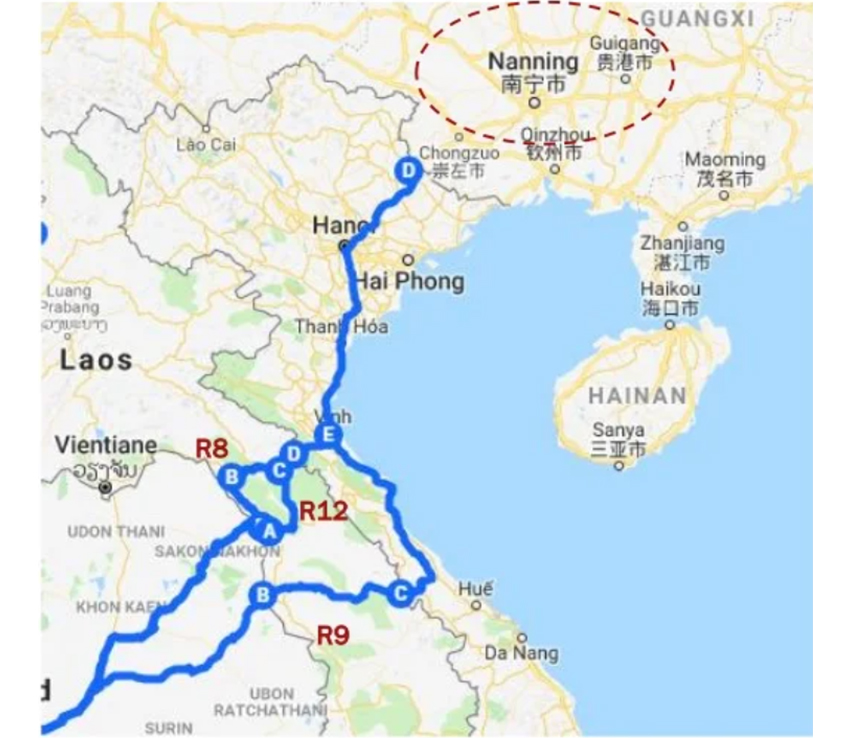
Threats and Difficulties of R9 Route
Traffic Issues;
Transit traffic, Toll fees collection in Lao, The markup at China Custom, Speed limit.
Trade Issues;
Single-Stop Inspection (SSI) is difficult to achieve, Unpredictable trading regulation of Laos, Inefficient advance exchange of information, Illegal and Trade between Vietnam and China.
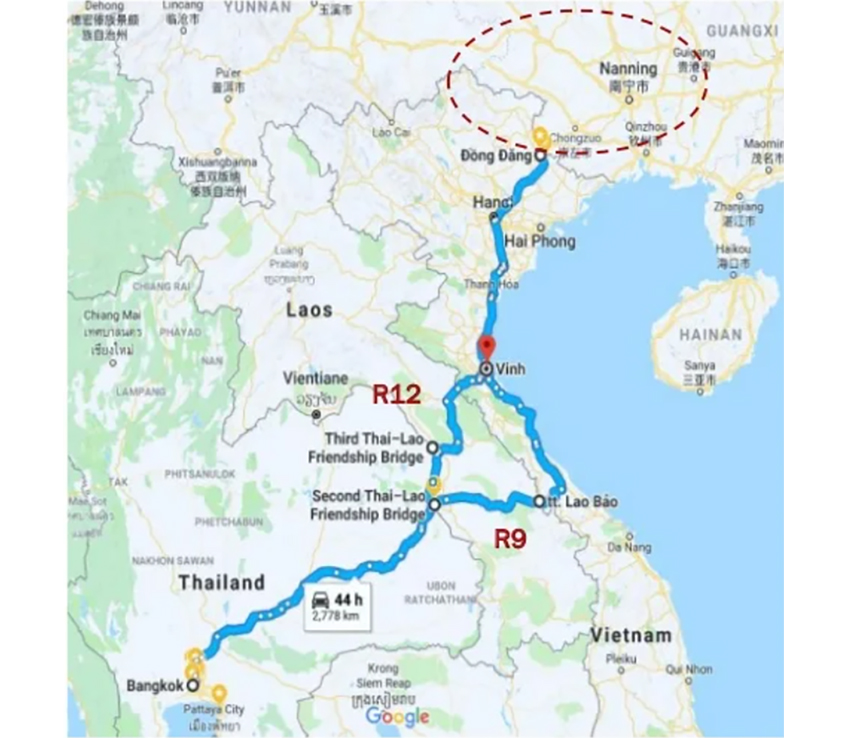
R12 has potentiality and readiness relative to R9
R12 is shorter and faster than R4. The facility along R12 is in substantial level which implied to GMS and international standard. The transport and trade facilitation is also implied international and GMS Standard.
Business Opportunities in GMS Economic Corridor
The opportunities of Trade and investment for investors in the GMS Economic Corridors, the understanding of the Software Connectivity and Cross-Border Transport Agreements in the Greater Mekong Sub-region Cross Border Transport Agreement (GMS CBTA) or GMS Economic Corridor is logistics connecting 6 major cities of Greater Mekong Sub-region (GMS) countries, comprising Thailand, China (Yunnan), Vietnam, Cambodia, Laos and Myanmar.
It is regarded as a strategic area for trade, investment and regional development are purchasing power of more than 250 million people, total area of 2.3 million square kilometers, equal to Western Europe. They have abundant resources with strategic location where is the center of the connectivity of South Asia, East Asia and Southeast Asia.
The ASEAN Economic Corridors or GMS Economic Corridors is the essential connection with the countries within and outside ASEAN region. GMS Economic Corridors designates as logistics routes of raw material, products and tourists that increase continuously. Not only the availability of infrastructure and utilities, but also connectivity of software is required to facilitate and to simplify the complex transportation process.
The Great Mekong Sub-region Cross Border Transport Agreement (GMS CBTA) was established on 26 November 1999 with the aim of promoting and facilitating transportation of goods and passengers among countries in the GMS. It consists of 20 protocols with the following key points:
- Facilitating of cross-border freight transport among countries in the GMS
- Single Stop Inspection and Single Window Inspection
- Integration of various related system, such as the customs system, the immigration system and safety inspection system and product standards
- Exchange of Traffic Rights by allowing vehicles of GMS countries to manage logistics of countries in the GMS under the vehicle quota of each country
- Facilitating immigration of individuals Inspection At present, GMS members signed the agreement and ratified all 20 protocols that Myanmar ratified the Third Protocol as the last one on September 18, 2015. The GMS CBTA is now applicable.
After the GMS CBTA, Asian Development Bank (ADB), the major sponsor of finance, has suggested some annex and protocols should be reviewed and revised to the current situation and economic conditions. It supports the expansion of trade, investment and tourism in the region effectively. Recently, January 1, 2017 was the starting date of issuing road transport permits in the Greater Mekong Sub-region (GMS Road Transport Permit) under the GMS CBTA.
ASEAN is Thailand’s no.1 export market connecting Southeast Asia region via the ASEAN Economic Corridors (GMS Economic Corridors). That are both Hardware Connectivity and a Software Connectivity to help strengthen Thailand’s capability in transport and logistics. It increases channels and opportunities for Thai entrepreneurs who invest or looking for investment opportunities in neighboring countries more conveniently, especially distribution and prosperity of provinces connecting to the Economic Corridors such as Tak, Phitsanulok, Khon Kaen and Mukdahan.
Therefore, entrepreneurs should closely monitor the update of the ASEAN Economic Corridor or GMS Economic Corridors.
Sources: Department for International Trade, Ministry of Foreign Affairs
by Business Information Center : BIC (Thaibiz)